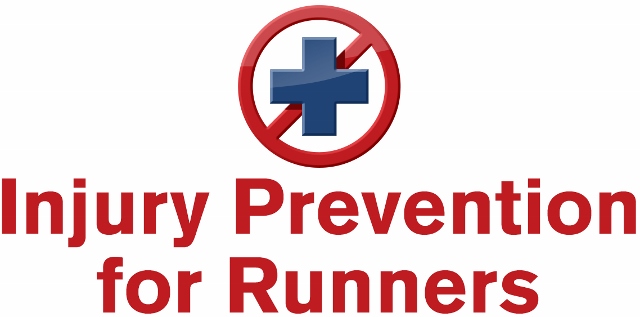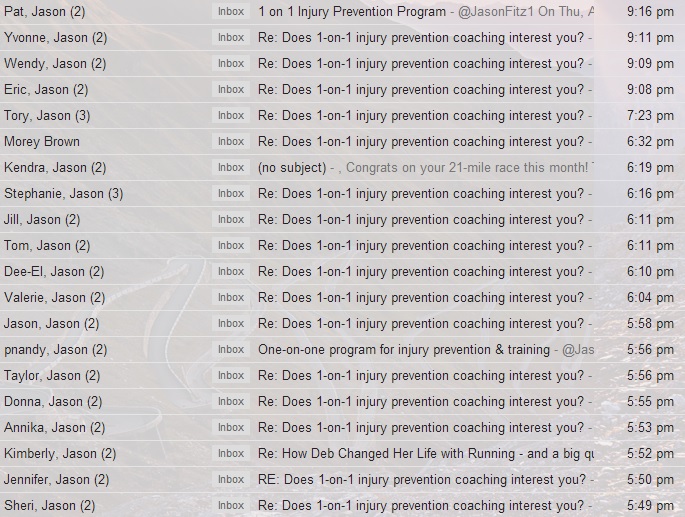Learning about injury prevention from the brightest minds in the sport has its advantages.
Forget anecdotal advice that might work for one person, but isn’t universal. Instead, doesn’t it make more sense to go straight to the experts?

You wouldn’t get parenting advice from me (I’ve been flying by the seat of my pants for the last 5 months!), so why would you ask your top running questions to a random person you met at your local 5k? Is it really productive when that person has no specific training, coaching experience, or education on the subject?
These are the haunting questions that keep me up late at night.
I prefer a strategy of learning from those at the top of the field. Fortunately, for the first eight years of my running career I was able to run for over ten coaches who were both accomplished runners and teachers of the sport. When I had a question or needed advice, I turned to someone who had won “coach of the year” awards, run a 2:36 marathon, and had over 20 years of experience.
Never before had I learned so much about running.
And several months ago when I opened my 1-on-1 Injury Prevention Coaching Program, I wanted to provide the highest level of education about injury prevention possible. I fully understand that I don’t have all the answers, so I went straight to the experts.
Runners in that program had a rare and valuable opportunity: they could ask their top questions to five of the most highly regarded running experts in the field.
Last week, I shared several insights from world-class experts Matt Fitzgerald and Alex Hutchinson.
Meet the Experts
And today, I want to share even more. The other three interviewees were Brad Hudson, Greg Lehman, and Peter Larson.
Brad Hudson is an elite coach to National Champions and Olympians like Dathan Ritzenhein, Alan and Shayne Culpepper, and Tera Moody.
He is also the author of Run Faster from the 5k to the Marathon: How to Be Your Own Best Coach and the founding coach of the Marathon Performance Training Group based in Boulder, CO.
Greg Lehman is a physiotherapist, chiropractor, and exercise biomechanics expert with over 15 years of clinical experience. He is also a former lecturer at St. Lawrence University with over 20 published papers that won him “Researcher of the Year” by the Ontario Chiropractic Association.
Peter Larson is a former biology and anatomy professor at St. Anselm College and a Boston Marathon qualifier. He is also an author of the book Tread Lightly: Form, Footwear, and the Quest for Injury-Free Running.
He now works as a running coach and exercise physiologist while writing the popular Runblogger website, which is recognized as a leading site for running shoe innovation and running form information.
Brad Hudson: What Motivates You?
When I called Brad to interview him he was in the car coaching a group of professional runners as they ran a workout. If that’s not the most fitting back story for an interview with an elite coach, I’m not sure what is.
Brad is perhaps best known for coaching elite runners – particularly marathoners – and his book Run Faster. I’ve mentioned before that it is my favorite training book of all time.
So you may be surprised that I’m not going to share a juicy training strategy or special tactic for injury prevention. Brad shared plenty in the interview, but what most stood out to me was his approach to race selection.
I asked him about a particularly injury-prone runner and if a marathon was a good idea seven months from now. Before I finished asking the question, I thought I knew what his answer would be: “of course not, the marathon is very challenging so this runner should focus on getting healthy and then tackle the marathon.”
But he surprised me with his candid response. And I think it shows race selection is about more than just training:
“The sport is hard enough. I think it’s important that athletes train for events that motivate and inspire them. So if the marathon is something that’s calling them and they want to do it, then go do it.
There’s a lot of different levels of running a marathon – you can race one, you can run to finish. It just depends on what you want to do. I would have this person run a marathon just to finish. And with time and consistency, they can then race a marathon, if that’s what they want to do.”
Brad’s response has more to do with injury prevention than you might think. How many of us are truly inspired by our goals? Are you setting goals that scare you? Or are you settling?
When runners are motivated by their goals their consistency with training – and ability to do the little things that keep you healthy – is vastly improved. Without inspiration, you’ll slack off. You’ll cut corners. And you won’t have the drive to push yourself to be the best runner you can be.
Some of us already know what we need to be doing to stay healthy. But we still don’t do it. That’s where motivation can help us stay consistent and finally accomplish more than we thought possible.
“You’re always writing your own rule book” – Greg Lehman
What I love about Greg’s approach to injury management is that there are no rules. Everything is a shade of grey (there are 50 of them) and is dependent on a host of issues.
You might think that’s a little obnoxious. How are you supposed to apply this to your own training if there are no rules to follow?!
But his advice works because it empowers each runner. Greg acknowledges that we’re all individuals with very different physiologies. What works for you might not work for me.
So when I asked him about adjusting training for older runners, his answer hit the nail on the head. Of course there are some general principles to follow. If you’re older than 50, make sure you follow these guidelines:
- Double down on strength work. Maintaining muscle mass is critical as you get older and it must be a regular part of your training
- Forget what you did in your 20’s, 30’s, and even 40’s. Adjust your expectations.
- Put more emphasis on cross-training and supplement exercises
Unfortunately, running doesn’t come first when you’re an older runner.
I then asked Greg what he thought about reducing maintenance runs and focusing on quality days like the long run and faster workout. Is that a viable strategy for older runners? He told me:
Yes – I certainly recommend that but you also have to determine if you’re the type of person who needs to do that. I know people who still run every day. That’s why it’s hard to set rules.
So case by case, and yes, if you keep getting injured you have to try something new. You’re always writing your own rule book.
You can follow Greg on Twitter for more advice here: https://twitter.com/greglehman
This is also why personal coaching and custom training programs are so valuable. Every runner is unique and while general training principles are universal, you must find what works for you as an individual.
Your rule book is exactly that: yours.
Running Form and Cues with Peter Larson
Peter Larson has been analyzing running form for years on Runblogger. And while it’s easy for me to describe what optimal form looks like, Peter has deep experience in a formal gait analysis lab helping runners get to the bottom of their injury problems.
And more helpful than any description of what your form should look like, are the specific mental cues that make changes easier to accomplish.
Here’s a quick example: most of us know that over-striding is a bad thing that leads to a variety of inefficiencies and injury risks. But how do you actively reduce over-striding?
That’s where cues come in. Peter says:
Imagine that you’re on a scooter. As a way for you to get your foot pushing behind you, driving from the hips, use a mental image of you pushing the ground like you’re on a scooter.
Another one that I like is imagining that someone is pulling your head up by a string attached to the top of your head to encourage good posture.
Sounds deceptively simple, but the implications are enormous. Hip drive, landing with your foot underneath your center of mass, and good posture are the hallmarks of sound running form. These two cues can help you accomplish all three.
Later in the interview, Peter shares even more. But the message is clear: simple cues that shape how you think about your running form are often the most powerful ways to run more efficiently and prevent injuries.
Injury Prevention for Runners
When I started writing about injury prevention – talking about the success that my runners Sarah and Deb have seen – the response that I got from the SR community was enormous. I shared this image of my overflowing inbox when I asked if you’d be interested in an injury prevention coaching program:

So I got to work and put together the most comprehensive program possible: coaching lessons, interviews with these world-renowned experts, new strength routines in high-quality video, and training plans designed to keep runners healthy.
As with any 1-on-1 personal program, I couldn’t help hundreds of people (can you imagine how crazier my inbox would be?) so it was limited to just fifteen runners.
But soon the Injury Prevention for Runners course will be available for those who are struggling with injuries – sign up here to get on the notification list. You’ll get the same coaching lessons, videos, and interviews with these experts.
I’m thinking big so there’s going to be even more Q&A, upgraded and revised lessons, a training plan library, and specific injury treatment programs.
I’m working out the final details now and it will be ready after the New Year. My goal is to help those with chronic injury problems finally run healthy. And I hope you’ll see the same success as Julie and Don:
“This program really taught me that running alone was not the key to being a good runner. Nor will it keep you injury free. I know that there is more to running and staying fit….I feel like I have the secret now!!” – Julie
“Jason’s emphasis on injury prevention over the long term has made a real difference in my running and now I feel like I have a good, doable plan for getting faster while staying healthy. And I love that he brings in other experts to provide their specialized knowledge.” – Don
After spending thousands of dollars of my own money to research the best prevention and treatment strategies over the last two years (seriously, I once find myself in a woo-woo yoga workshop for THREE HOURS), I’ll launch this new program next year when it’s fine-tuned and ready for you.
Add yourself to the Injury Prevention list and I’ll let you know as soon as it’s ready. Plus, I’ll share two Q&A videos about injuries to help you avoid common mistakes I see all the time.